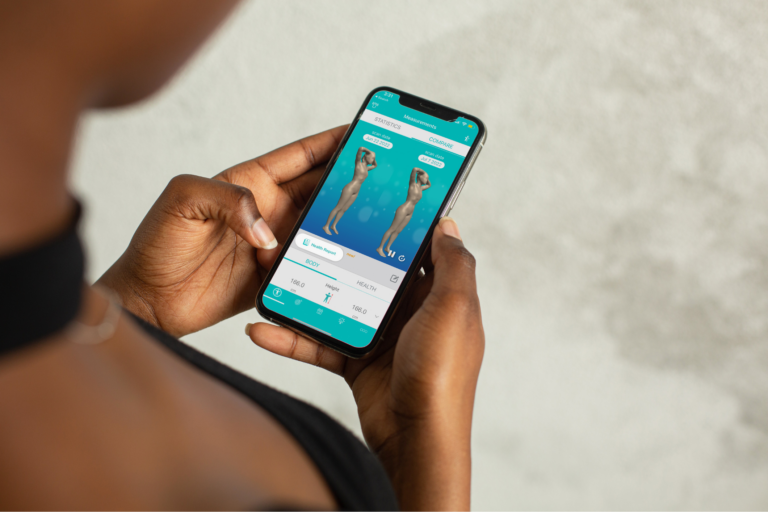BLOG:
3D Body Scanning vs Bioelectrical Impedance Analysis (BIA)

The fitness industry has undergone significant technological advancements in recent years, and one such improvement is the use of 3D body scanning and Bioelectrical Impedance Analysis (BIA) technology for assessing body composition. These methods have gained popularity among fitness industry professionals and gym owners for providing detailed information on a person’s body composition, including muscle mass, body fat, and circumference measurements.
In this blog, we’ll compare 3D body scanning and BIA technology to help fitness industry professionals and gym owners make informed decisions when choosing between the two.
What is 3D Body Scanning?
3D body scanning is a non-invasive method of capturing a 3D model of a person’s body. It involves the use of infrared sensor(s) to measure the body’s surface and create a 3D model of the body. Body composition is then calculated using formulas based on your body’s volume.
This method also gives accurate measurements of the body’s circumference and a 3D visualisation of the body, which can be helpful when tracking progress on a fitness or training program.
Bodymapp scans are an affordable, convenient and accessible option for 3D body scanning. The app utilises the depth sensor in compatible mobile models to capture thousands of data points to map the contours of the user’s body. Bodymapp captures 20 body measurements – including body fat percentage, lean mass, waist, hips, thighs and more – and creates a unique 3D body avatar.
What is Bioelectrical Impedance Analysis (BIA)?
Bioelectrical Impedance Analysis (BIA) is another non-invasive method of measuring body composition. It works by sending a low electrical current through the body and measuring the resistance to the current.
The resistance to the current is then used to calculate the amount of body fat, muscle mass, and hydration levels in the body. BIA is a quick and easy method that can be done using handheld devices or scales with BIA technology. Popular BIA scanners include InBody and Evolt360.
Comparing 3D Body Scanning and BIA Technology
Both 3D body scanning and BIA technology have their advantages and disadvantages when it comes to assessing body composition.
Accuracy
Accuracy is one crucial aspect of body composition assessment. 3D body scanning provides highly accurate results as it captures a 3D model of the body that is not affected by factors such as hydration levels, food intake, or exercise. Bodymapp 3D body scans are accurate to within +/- 10mm for circumference measurements and 3-4% of a DEXA scan for body fat percentage.
In contrast, BIA technology can be affected by factors such as hydration levels, food intake, and exercise, making the accuracy of BIA results somewhat variable.
Convenience
When it comes to convenience, traditional forms of 3D body scanning that require specialised equipment can be time-consuming. But with Bodymapp, the process is more convenient than ever as it can be accessed via iPhone or iPad, allowing gym members to either scan at home or use an iPad in the gym. The process is fully automated, so there’s no need to have trainers on hand to assist with scanning.
BIA scans can be completed using handheld devices or scales with BIA technology, making it a relatively convenient method of body scanning as well. However, it usually requires some form of equipment, which takes up space in the gym, and staff will need to be available to assist members with scanning.
Cost
Cost is also a crucial factor when it comes to choosing between 3D body scanning and BIA technology. Traditional forms of 3D body scanning can be relatively expensive, but Bodymapp offers an affordable alternative to traditional methods of body scanning. You can start offering Bodymapp 3D body scans to your customers at no little to no upfront cost to the business.
BIA technology is a popular choice among fitness industry professionals and gyms, but it does usually come with a hefty price tag. BIA requires expensive equipment, plus staff wages, as you’ll need to have trainers available to assist members with scanning.
In summary
When it comes to choosing between 3D body scanning and BIA technology, there is no one-size-fits-all solution. Choosing between 3D body scanning and BIA technology ultimately comes down to the individual needs and preferences of the fitness industry professional or gym owner. In the end, it’s all about finding the right fit for your business.
Both 3D body scanning and BIA technology can offer valuable insights into a person’s body composition, so it’s important to weigh the pros and cons of each method and choose what’s best for you and your customers.
If you’re interested in offering 3D body scanning to your customers, check out Bodymapp! With our affordable and convenient technology, you can provide your customers with an accurate and detailed picture of their body composition. Click here to learn more about our partnerships and how we can help your business.





